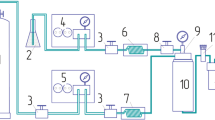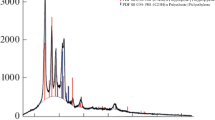Abstract
Blends of isotactic PP and HDPE of various compositions are prepared by melt extrusion in two crystallization modes. The first series of composites is obtained by a rapid cooling of the melt (≈8000°C/min). According to X-ray diffraction and microscopy studies, pure PP forms a smectic mesophase under these conditions. In contrast, the PP component in the blends crystallizes in the form of monoclinic α crystals into spherulites with a diameter of ~4–5 µm. The PE component of the composites has a lower enthalpy of melting than pure PE, and it decreases with an increase in the PP content in the system. This may be due to formation of the interphase layer where PE and PP molecules are intermixed at the molecular level. Estimation according to the Gelfand theory shows that the thickness of the boundary layer in the composites of the first series is about 30 nm. The second series of composites is obtained by a slow cooling of the melt (≈2°C/min). All samples of this series contain large (~80–120 µm) radial spherulites, but in the blends, their size is somewhat smaller than that in pure PP. The enthalpy of melting of PE and PP components in the blends of the second series does not depend on composition and is equal to the corresponding values for pure PE and PP. Apparently, upon slow cooling of the melt of two polyolefins, the molecules from the interphase layer have time to move to the corresponding domains and an ordinary two-phase system without a “transition” zone is formed. Owing to the developed interfacial zone in the composites of the first series, the phases are deformed together and these materials show a good deformation behavior. In the composites of the second series, all mechanical parameters are worse than those of pure polymers and blends of the first series (the “antagonistic effect”) because of the absence of an extended boundary layer.










Similar content being viewed by others
REFERENCES
J. W. Teh, A. Rudin, and J. C. Keung, Adv. Polym. Technol. 13, 1 (1994).
A. Graziano, S. Jaffer, and M. Sain, J. Elastomers Plast. 51, 291 (2019).
N. A. Erina and E. V. Prut, Polym. Sci., Ser. A 42, 183 (2000).
T. G. Mofokeng, V. Ojijo, and S. S. Ray, Macromol. Mater. Eng. 301, 1191 (2016).
M. Krishevski, T. Pakula, and Ya. Grembovich, Vysokomol. Soedin., Ser. A 26, 1569 (1974).
S. Jose, A. S. Aprem, B. Francis, M. C. Chandy, P. Werner, V. Alstaedt, and S. Thomas, Eur. Polym. J. 40, 2105 (2004).
J. Krajenta, A. Pawlak, and A. Gałeski, Polimery 60, 664 (2015).
L. Nielsen and E. Lawrence, Mechanical Properties of Polymers and Composites (Marcel Dekker, New York, 1974).
J. Manson and L. Sperling, Polymer Blends and Composites (Acad. Press, New York, 1976).
S. Wu, Polym. Eng. Sci. 27, 335 (1987).
I. P. Miichenko, Technology of Semi-Products of Polymer Materials. Manual (Nauch. Osnovy i Tekhnol., St. Petersburg, 2012) [in Russian].
V. N. Kuleznev, Blends and Alloys of Polymers (Nauch. Osnovy i Tekhnol., St. Petersburg, 2013) [in Russian].
Q. Zia, H.-J. Radusch, and R. Androsch, Polym. Bull. 63, 755 (2009).
D. W. Van Krevelen, Properties of Polymers Correlations with Chemical Structure (Elsevier, Amsterdam; London; New York, 1972).
L. Mandelkern, Crystallization of Polymers (McGraw-Hill, New York; San-Francisco; Toronto; London, 1964).
J. D. Hoffman, G. T. Davis, and J. I. Lauritzen, in Treatise on Solid State Chemistry (Springer, Boston, 1976), Vol. 3, p. 497.
D. Libster, A. Aserin, and N. Garti, Polym. Adv. Technol. 18, 685 (2007).
C. Marco, M. A. Gómez, G. Ellis, and J. M. Arribas, J. Appl. Polym. Sci. 84, 1669 (2002).
M. V. Glikshtern, Polim. Mater., No. 6, 13 (2002).
C. Marco, M. A. Gomez, G. Ellis, and J. M. Arribas, J. Appl. Polym. Sci. 86, 531 (2002).
X. Li, K. Hu, M. Ji, Y. Huang, and G. Zhou, J. Appl. Polym. Sci. 86, 633 (2002).
K. Hoffmann, G. Huber, and D. Mäder, Macromol. Symp. 176, 83 (2001).
J. Li, J. Xu, and M. J. Mannion, US Patent No. 7781511 (2010).
E. Helfand and Y. Tagami, J. Polym. Sci., Part B: Polym. Phys. 9, 741 (1971).
E. Helfand, and Y. Tagami, J. Chem. Phys. 56, 3592 (1972).
A. M. C. Souza and N. R. Demarquette, Polymer 43, 1313 (2002).
E. M. Antipov, Doctoral Dissertation in Chemistry (INKhS RAN, Moscow, 1990).
M. Rubinstein and R. Colby, Polymer Physics (Oxford Univ. Press, Oxford, 2003).
Yu. S. Lipatov, Interfacial Phenomena in Polymers (Naukova dumka, Kiev, 1980) [in Russian].
A. Yu. Grosberg and A. R. Khokhlov, Physics in Polymer World (Nauka, Moscow, 1989) [in Russian].
Funding
This study was supported by the Russian Foundation for Basic Research (project no. 20-03-00168-a).
Author information
Authors and Affiliations
Corresponding author
Rights and permissions
About this article
Cite this article
Shklyaruk, B.F., Gerasin, V.A., Guseva, M.A. et al. Influence of the Crystalline Structure of Components and the Boundary Layer between Them on Mechanical Properties of Polypropylene–High Density Polyethylene Composites. Polym. Sci. Ser. A 63, 533–541 (2021). https://doi.org/10.1134/S0965545X21050138
Received:
Revised:
Accepted:
Published:
Issue Date:
DOI: https://doi.org/10.1134/S0965545X21050138




